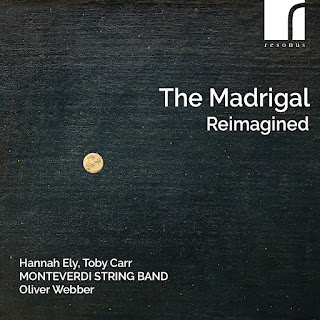The Madrigal Reimagined: Claudio Merulo, Johann Nauwach, Claudio Monteverdi, Cipriano de Rore, Cristofano Malvezzi, Giulio Caccini, Emilio de’Cavalieri, Giovanni Gabrieli, Giovanni Perluigi da Palestrina, Lorenzo Tracetti; Hannah Ely, Toby Carr, Monteverdi String Band, Oliver Webber; Resonus Classics
Reviewed 2 August 2024
A wonderfully satisfying recital that mixes didacticism with sheer vocal and instrumental dazzle as Oliver Webber and his ensemble explore how the madrigal went from simple song to something more elaborate and more complex
As Oliver Webber explains in the booklet notes for The Madrigal Reimagined on Resonus Classics, “At a meeting of the Florentine Academy in 1577, the poet Giovanni Battista Strozzi gave a lecture on a poetic form that was rapidly gaining in popularity: the madrigal. A short poem of no fixed rhyme and structure, it was, Strozzi explained, ideally suited to the depiction of gentle scenes of love rather than heroic deeds or tragedy; indeed, rather than profundity, its essence lay in an elusive charm, which Strozzi encapsulated with the phrase un non so che del frizzante, ‘a little something sparkling’ – or, according to some dictionaries of the period, ‘stinging’.”
From this intriguing but not exactly earth-shattering beginning grew a significant musical structure as composers reinvented and reimagined settings of these verses. The madrigal is at the heart of seconda prattica and would lead, in one direction, to the first operas, but there are other directions too.
On this disc, Webber and the Monteverdi String Band are joined by Hannah Ely (soprano) and Toby Carr (Renaissance lute and theorbo) for a programme that takes us from the earliest madrigals through vivid instrumental reinventions and ending up with music from Monteverdi’s L’Orfeo. Monteverdi’s seconda prattica broke rules for expressive purposes. The disc explores the different elements that different composers brought to their exploration of the madrigal.
After an instrumental introduction from Claudio Merulo, we have some compare and contrast, the madrigal Cruda amarilli in a sung version by Johann Nauwach (a pupil of Schutz) and an instrumental version by Monteverdi, followed by variations and arrangements of Cipriano de Rore’s Anchor che col partire, showing how ornamentation could embellish and at the same time make more expressive. This is cue for a wonderful solo from Webber with a dazzling, yet expressive account of Orazio Bassani’s diminutions on Cipriano de Rore’s Vergine Bella and later on in the disc Webber returns to de Rore’s madrigals with his own diminutions on two more, wonderful stuff that helps us recapture the expressive dazzle that is sometimes missing from contemporary performances of music that was not completely written down.
Another important element was dance, and we hear a group of pieces from Monteverdi’s Il Ballo dell’Ingrate, an extended madrigal that has dance at its core but which also points us forward to the development of opera.
Then we move towards opera from a different direction as we hear three musical excerpts from the 1589 Florentine Intermedi, lavish staged entertainments that combined the most advance music with sophisticated designs and staging. Not opera, but getting close and with the madrigal at their heart. We heart the sober dignity of Cristonfani Malvezzi’s Sinfonia from the fourth intermedio, La Regione dei Demone, then the intensity of Giulio Caccini’s Io che dal ciel also from the fourth intermedio, with its brilliant ornamentation originally sung by Caccini’s wife (here dazzlingly done by Hannah Ely). The music and its dazzle distracting momentarily from the spectacular staging. Finally, in this group, Emilio de’ Cavaliere’s O che nuovo miraculo from the sixth intermedio, where dance is to the fore.
Examples of reinventions of Palestrina and Cipriano de Rore demonstrate that ornamentation and divisions was not necessarily a solo speciality.
We then finish with a sequence from Monteverdi’s L’Orfeo where the vividness of the playing and the sheer stylistic brilliance more than makes up for the restrictions in instrumental colour. With just Hannah Ely, the string ensemble plus Toby Carr, we can hear quite clearly how Monteverdi is using the elements of ornament, dance, rhythm and harmony to create an expressive palate that goes way beyond the simple idea of a madrigal as an entertainment.
As ever with Oliver Webber and the Monteverdi String Band’s discs, you can listen to this a number of ways. There is a clear didactic element, introducing and exploring the complexities of what happened to the madrigal during the first two generations of composers exploring its possibilities. But the recital is wonderfully satisfying simply as a recital, with everything performed in vivid style.
The Madrigal Reimagined
Hannah Ely (soprano)
Toby Carr (Renaissance lute, theorbo)
Monteverdi String Band
Oliver Webber (violin & director)
Recorded in St Michael’s Church, Highgate on 21–23 November 2023
RESONUS CLASSICS RES10341 1CD [63.41]
Never miss out on future posts by following us
The blog is free, but I’d be delighted if you were to show your appreciation by buying me a coffee.
Elsewhere on this blog
- Confidence, style and engagement: Rossini’s The Barber of Seville at West Green House Opera is a complete delight – opera review
- An eclectic mix: Brixton Chamber Orchestra at Clapham Park Cube – review
- Prom 10: Ryan Wigglesworth, Laura van der Heijden & BBC Scottish Symphony Orchestra in Britten, Cheryl Frances Hoad & Elgar – concert review
- She played and sang: Gillian Dooley’s new book is the fruit of 15 years research on Jane Austen’s music collection – interview
- A world away from the Bibilical oratorio: Stanford’s Whitman setting is the focus for this disc of two of large-scale choral works – record review
- A vividly realised recording: rediscovering music by Latvian-American composer Gundaris Pone – record review
- Returning to Northern Ireland Opera for his third role, British-Ukrainian baritone Yuriy Yurchuk on Tchaikovsky’s Eugene Onegin – interview
- Relentlessly entertaining: Handel’s Acis and Galatea at Opera Holland Park rather over-eggs things but features finely engaging soloists – opera review
- Contemporary contrasts: Wolf-Ferrari’s Il segreto di Susanna & Leoncavallo’s Pagliacci in a satisfying double bill at Opera Holland Park – opera review
- A sound world that is distinctive, appealing & engaging: Maria Faust’s Mass of Mary on Estonian Record Productions – record review
- A rich sophistication of thought running through this programme that seems worlds away from the typical debut recital: Awakenings from Laurence Kilsby & Ella O’Neill – record review
- Home







